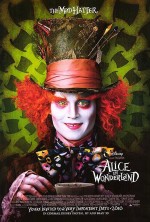
“Alice in Wonderland,” had its successful moments, but overall it was surprisingly sluggish. Excluding Johnny Depp, the film seemed more like a Burton imitation than something he actually did himself.
“Alice” also had the bad luck of being the first major 3-D release to come out after “Avatar”, and if you take into account that Burton chose to shoot in 2-D and then have the footage converted, it obviously plays like one of the final gaps of the old-fashioned ways of doing things.
In this version, Alice is introduced as a 6-year-old girl troubled by visions of falling down a hole and seeing different creatures, incidents her dad assures her are nothing but dreams.
It then continues 13 years later and Alice is a disobedient young woman (Australian actress Mia Wasikowska) who is headed for a high-class garden party with her mother. Alice is a bit of rebel (she doesn’t wear a corset!) and though she doesn’t know it, she’s on the way to what her family hopes will be her engagement party to a not-so-charming, aloof man.
Once we meet Alice’s perspective suitor named Hamish, we know that the marriage is not going to happen. This part of the film is so dreary that the audience is anxious to escape into the rabbit hole, and get to the more interesting part of the film that we all expect.
Alice is soon frantic to escape as well and following the white rabbit (voiced by Michael Sheen), she dashes down the hole where she meets a world of awe where animals talk and even flowers speak their minds.
Reflecting on the capacity of Burton’s imagination, it’s not unexpected that many of these creatures are engaging.
The rambunctious Cheshire Cat (Stephen Fry) is hard to forget, as are Absolem the Blue Caterpillar (Alan Rickman), Bayard the Bloodhound (Timothy Spall) and noted fright celebrity Christopher Lee as the dread Jabberwocky.
Slightly less entertaining is the script’s beginning plot in which the creatures spend much of their time squabbling as to whether this Alice is the same person who came down the rabbit hole a decade earlier and, if she is, whether she has “lost her muchness” in the past years. They even give her a hard time for getting the name of the location wrong. They call it “Underland,” she is told, “not Wonderland.”
These clashes soon become tiresome, even as Johnny Depp is on screen. His Mad Hatter is a genuine fashionista whom we see designing wacky headgear. There’s no denying Depp’s gifts and abilities, but this performance felt both self-satisfying and redundant.
The film took a generic turn as it incorporated the inevitable good vs. evil battle to end all battles. Inspiring the powers of light is the White Queen (Anne Hathaway), while ruling the wicked side is her sister, the narcissistic Red Queen (Helena Bonham Carter) and Stayne, the Knave of Hearts ( Crispin Glover), her 7-foot-6 top general.
All these characters are in debate about Alice because it turns out that a respected document called the Oraculum has foretold that Alice will return to lead the forces of light and slay the dark side’s champion, the powerful Jabberwocky.
Alice, of course, insists she is the nonviolent sort and likely to do no such thing, that she knows of…
With battle scenes in place to please the boys, Burton and company have taken special care to provide pictures of Alice as a warrior princess in full Joan of Arc armor as a female empowerment image for the girls in the audience.
While these film techniques is always in short supply, it would be nicer if these images—and the movie as a whole—felt a little more like situations that came from the heart, and a little less like corporate attempts to please.






